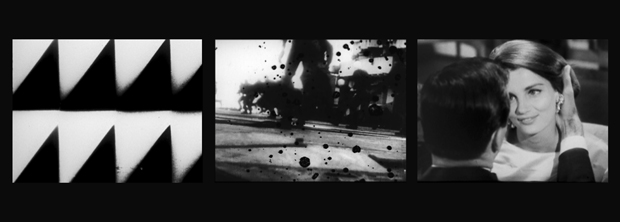Rose gets Bruce Conner work for 50th anniversary
Original film triptych 'EVE-RAY-FOREVER' appeared at Rose in 1965
 Rose Purchase Fund and Mortimer and Sara Hays Acquisition Fund, 2011. Film stills courtesy of Conner Family Trust © Conner Family Trust.
Rose Purchase Fund and Mortimer and Sara Hays Acquisition Fund, 2011. Film stills courtesy of Conner Family Trust © Conner Family Trust. Bruce Conner, 'EVE-RAY-FOREVER' (1965/2006)
In celebration of its upcoming 50th anniversary, the Rose Art Museum has a provocative new piece that, like the building itself, is beginning a second life.
“EVE-RAY-FOREVER (1965/2006),” a triptych film installation originally shown at The Rose as part of the late artist Bruce Conner’s first major museum exhibition, in 1965, was born again after an unsuccessful attempt to restore it in 2001.“It was a really daring and amazing choice by The Rose,” says Dabney Hailey, the museum’s academic programs director. “It was controversial. It made people uncomfortable – in a good way.”
A Kansas native who later relocated to San Francisco and immersed himself in Beat culture, Conner emerged as an artist in the late 1950s and quickly became known for his assembled sculptures, collages, drawings and experimental films.
The work includes three black and white, silent, unsynchronized videos projected side by side.
Always a proponent of “recycling, reusing, reappropriating and borrowing,” according to Hailey, Conner composed the original triptych in 1965 of fragments of previous creations spliced together.
“The film that made up the triptych was all film that he had used somewhere else in a different way,” Hailey says.
Using three small projectors, Conner originally showed the films, silently, in a cordoned off a section of The Rose, which eventually became a common practice in galleries.
“People were in the same space as the projector,” Hailey says. "Film was supposed to be a fantasy. You weren’t supposed to see how the projector runs. It’s taboo.”
Back then, the 8mm film, transferred from 16mm film Conner originally used, ran on a loop for the full five or six hours the museum was open each day, with no fixed beginning or end; it began when a viewer started to watch it, and ended when the viewer chose to leave.
The 8mm cartridges were The Rose's first acquisition of moving images. In 2001, then-director Joseph Ketner approached Conner about restoring the work, and Conner decided to recreate the piece from scratch because the cartridges were too delicate to be restored. The original 16mm film from which they were made was also unavailable, as Conner had cut them over the years to use in creating other new pieces.
In a departure from his long-held belief in the natural disintegration of art, Conner digitally recreated “EVE-RAY-FOREVER (1965/2006),” frame by frame, over the course of several years.“The result is a physically new object. It’s a simulation of the original, or recreation, instead of restoration,” Hailey says. “It’s an artist looking back late in life and realizing this piece he made didn’t exist anymore but he could make it again.”
The community is invited to celebrate the Rose Art Museum’s 50th anniversary on Thursday, Oct. 27, from 5 to 8 p.m. On view in the newly renovated museum will be three exhibitions showcasing the university’s famed permanent collection.
Categories: Arts






